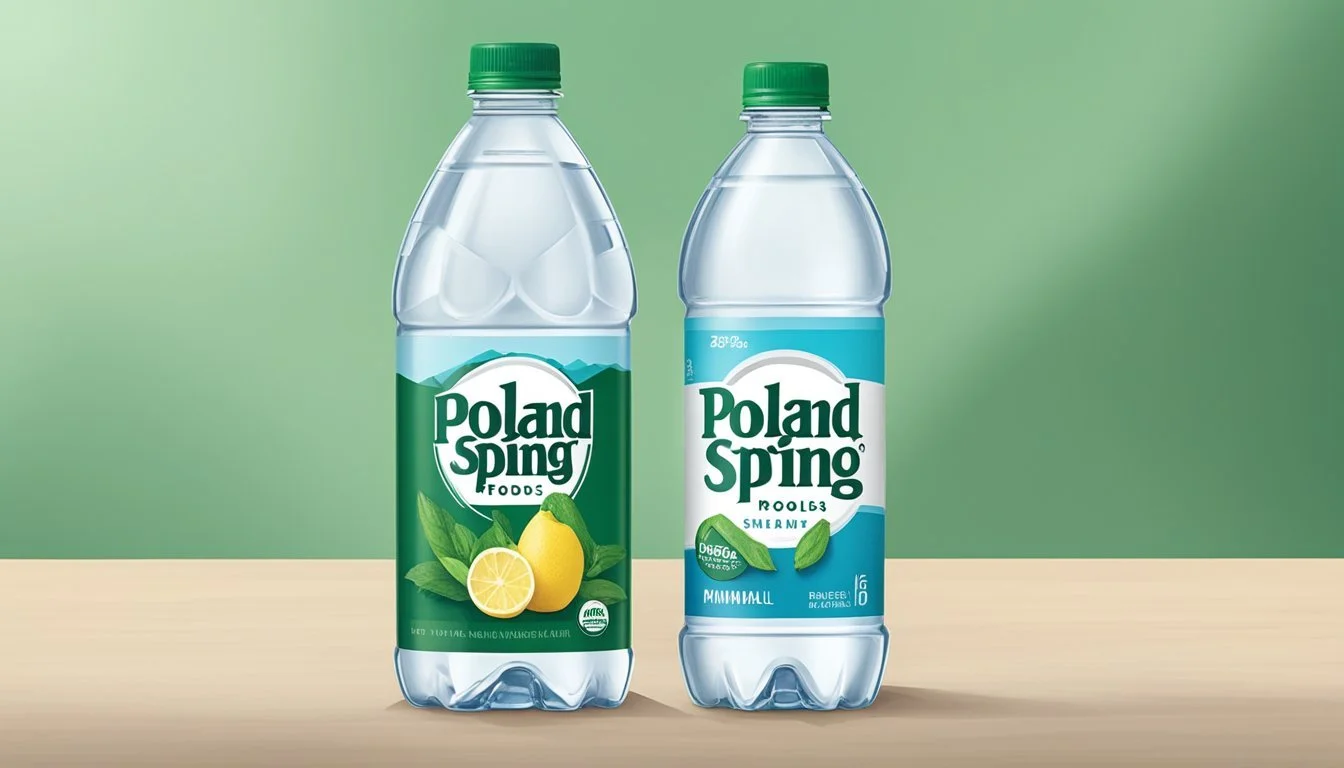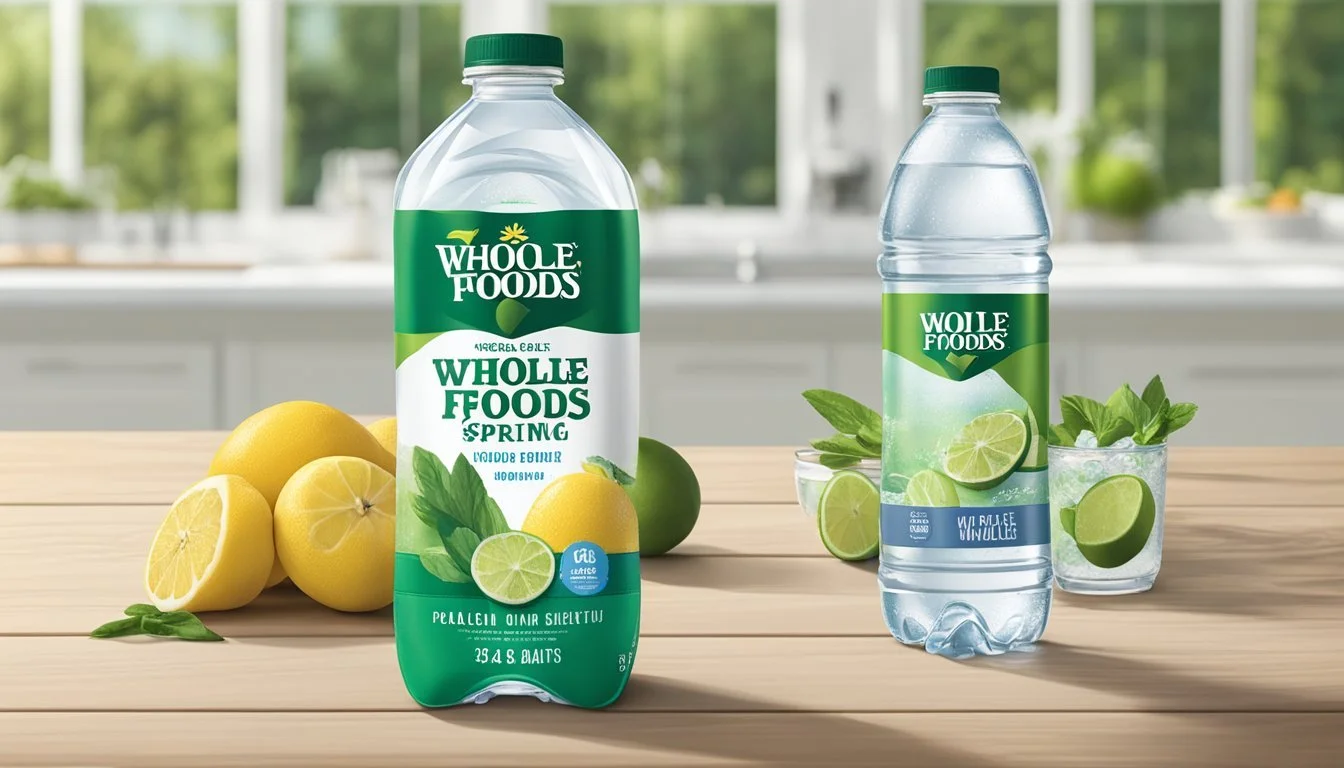Poland Spring vs. Whole Foods 365
Comparing Bottled Water Quality
Choosing the right bottled water can seem overwhelming with so many options available, but it ultimately comes down to quality and personal preference. Poland Spring and Whole Foods 365 are two popular brands that often come into consideration. Both brands claim high standards for their spring water, but there are distinct differences worth noting.
Poland Spring, a well-known brand, prides itself on meeting and exceeding FDA and EPA spring water requirements through rigorous testing. This ensures a consistent quality and purity, making it a favored choice for many who value these standards. On the other hand, Whole Foods 365 Spring Water, bottled by Spring Hill, offers a budget-friendly alternative while maintaining adherence to safety standards.
Hydration is a key aspect of choosing bottled water, and both Poland Spring and Whole Foods 365 provide reliable options. While Poland Spring's long-standing reputation and stringent testing might offer peace of mind, Whole Foods 365 provides a more economical choice without compromising on essential safety measures. The decision between the two will ultimately depend on individual preferences for brand trust and cost-effectiveness.
Brand Profiles
This section provides detailed information about Poland Spring's long history and origin and Whole Foods 365's market approach and water source. Both brands offer natural spring water sourced from unique locations, catering to different consumer preferences.
Poland Spring: A Nestlé Waters Brand
Poland Spring, a Nestlé Waters brand, has a rich history dating back to 1845. It is sourced from multiple springs in Maine, known for its naturally filtered water.
Poland Spring emphasizes its roots in the picturesque state of Maine, tapping into natural springs to deliver fresh-tasting water. The brand prides itself on its stringent quality control, ensuring that each bottle meets high standards.
Nestlé Waters, the parent company, has focused on maintaining the brand's reputation for purity. Poland Spring's offerings include a variety of sizes and packaging options, making it convenient for different needs.
Poland Spring appeals to consumers who prioritize trusted heritage and consistent quality in their bottled water choices.
Whole Foods 365: The Grocery Store's Label
Whole Foods 365 is the private label of the health-conscious grocery chain, Whole Foods Market. The 365 brand aims to provide affordable yet high-quality products, and their bottled water is no exception.
Sourced from natural springs, 365 bottled water is marketed towards shoppers who are mindful of budget and quality. Whole Foods ensures that its water meets standards for purity, often testing for contaminants and ensuring minimal environmental impact.
The brand emphasizes transparency, offering detailed information about the sources of their water. Whole Foods' commitment to sustainability extends to the 365 line, with eco-friendly packaging options.
Whole Foods 365 appeals to consumers looking for a balance of quality and affordability, with a focus on sustainable sourcing practices.
Water Sources and Production
Both Poland Spring and Whole Foods 365 water brands are sourced from different types of natural water bodies, each offering distinct characteristics related to purity, taste, and mineral content.
The Origins of Poland Spring
Poland Spring water is sourced from multiple natural springs primarily located in the state of Maine. Historically, the original Poland Spring gushed from a naturally occurring underground aquifer.
Today, the brand sources from several springs, such as Poland Spring in Poland, Clear Spring in Hollis, and Evergreen Spring in Fryeburg. These sources are carefully selected for their pristine quality and adherence to environmental regulations.
This multi-spring approach ensures consistency in taste and mineral composition, as the water is drawn from protected groundwater reserves. Once collected, the water undergoes minimal processing, preserving its natural mineral profile and purity.
How Whole Foods 365 Water is Sourced
Whole Foods 365 water, also marketed as 365 Spring Water, is typically sourced from various springs and public water sources. For instance, Spring Hill sources and bottles water for numerous brands including Whole Foods.
The water originates from natural springs, but it may also include municipal water treated to meet high standards. Whole Foods collaborates with several suppliers, adhering to stringent quality controls to ensure the water meets legal and safety guidelines.
This sourcing strategy allows Whole Foods to offer spring water with a consistent taste and quality that appeals to health-conscious consumers. The use of multiple sources helps maintain a stable supply, ensuring availability throughout their market regions.
Health and Safety Standards
Bottled water's health and safety standards are crucial, as they ensure the water is free of harmful contaminants like PFAS chemicals, lead, and arsenic. Both Poland Spring and Whole Foods 365 are subject to strict regulatory guidelines and testing protocols.
EPA and FDA Guidelines
The Environmental Protection Agency (EPA) and Food and Drug Administration (FDA) set guidelines for bottled water safety. The EPA oversees the standards for tap water, while the FDA regulates bottled water.
The FDA follows the EPA's standards closely, ensuring bottled water meets criteria for contaminants. Important limits include lead at 15 ppb and arsenic at 10 ppb. These limits are designed to minimize potential health risks.
Manufacturers must adhere to these legal limits to ensure consumer safety.
Testing for Contaminants
Both Poland Spring and Whole Foods 365 conduct regular testing to detect contaminants. Tests screen for heavy metals, such as mercury and arsenic, and PFAS chemicals, which are of particular concern due to their persistence in the environment.
Recent findings highlight that some bottled waters may contain PFAS levels exceeding recommended thresholds. Consumers should be aware of these findings and review the latest Consumer Reports testing results.
Regular testing ensures compliance with safety standards and helps maintain trust in the product's quality. Whole Foods 365 and Poland Spring are committed to providing safe and clean drinking water.
Water Quality and Purity
In evaluating Poland Spring and Whole Foods 365 bottled water, it's essential to consider both mineral content and how they compare to tap water in terms of purity and treatment.
Assessing Mineral Content
Poland Spring water is known for its natural mineral content, originating from springs in Maine. It includes calcium and magnesium, elements beneficial for health.
Whole Foods 365 Spring Water also contains natural minerals, although the company emphasizes purity and high-quality standards. Both brands undergo testing to ensure they meet FDA and EPA regulations.
Poland Spring:
Calcium: Contributes to bone health.
Magnesium: Supports muscle function.
Whole Foods 365:
Balanced mineral content.
Third-party verification ensures compliance.
Bottled Water vs. Tap Water
When comparing bottled water to tap water, several factors are crucial. Tap water in many regions is highly regulated and treated, often involving filtration and chlorination processes. However, it may still contain contaminants.
Bottled water like Poland Spring and Whole Foods 365 is often perceived as purer. Poland Spring is sourced from natural springs, while Whole Foods ensures their water undergoes reverse osmosis and other purification techniques.
Tap Water:
Subject to regional standards.
Uses filtration and chlorination.
Can contain residual contaminants.
Bottled Water:
Poland Spring: Natural spring source.
Whole Foods 365: Includes reverse osmosis for additional purification.
Meets stringent safety and purity standards.
Taste and Composition
Poland Spring and Whole Foods 365 bottled waters have distinct differences in flavor profiles and electrolyte content, which can influence consumer preferences. Understanding these factors can help consumers make informed choices based on their taste and hydration needs.
Flavor Profile
Poland Spring is sourced from natural springs, giving it a fresh, clean taste that many enjoy. Its natural mineral content contributes subtly to the flavor, making it a popular choice for those who prefer spring water.
Whole Foods 365, often purified through processes like reverse osmosis, has a more neutral taste. The purification removes impurities and natural minerals, resulting in a crisp and clean flavor but with less distinctive character compared to Poland Spring.
The Role of Electrolytes
Electrolytes are essential for hydration, and the presence of minerals like calcium, magnesium, and potassium can enhance water's hydrating properties and taste.
Poland Spring contains naturally occurring electrolytes, which not only contribute to its taste but also aid in maintaining balanced pH levels. This makes it a good choice for those seeking natural mineral water.
Whole Foods 365 often has added electrolytes to mimic the benefits found in natural spring water. These added minerals can vary, so it’s important to check the label. This can transform purified water into an effective electrolyte source, suitable for those needing replenishment during physical activities.
Packaging and Environmental Impact
Both Poland Spring and Whole Foods 365 have distinct approaches to packaging and environmental considerations. Poland Spring primarily uses plastic bottles while Whole Foods 365 offers more diverse options.
Bottle Materials and Sustainability
Poland Spring mainly packages its products in plastic bottles. These bottles are often labeled BPA-free, aiming to address health concerns. Their plastic packaging is lightweight, reducing transportation energy costs. However, they remain reliant on petroleum-based materials.
Whole Foods 365's offerings include plastic and glass bottles. Their glass bottles can be highly recyclable and reusable. Additionally, the company emphasizes environmentally friendly packaging, contributing to reduced plastic pollution.
Impact on the Environment
Plastic bottles, such as those from Poland Spring, have significant environmental footprints. They contribute to plastic pollution, and their production involves high energy consumption. Recycling rates for plastic remain low, thus increasing environmental stress.
Whole Foods 365’s glass bottles, although heavier, support better recycling rates and lower long-term environmental impact. The Environmental Protection Agency highlights the importance of using renewable packaging. Whole Foods 365’s strategy of using mixed materials reflects a more proactive stance on environmental protection.
Consumer Information and Advocacy
Insights into the quality and safety of bottled water often guide consumer choices. Understanding public perception and the role of investigative bodies is crucial.
Public Perceptions and Expectations
Consumers frequently turn to bottled water for its perceived purity and safety. Brands like Poland Spring and Whole Foods' 365 Spring Water are trusted due to their reputation and the quality assurance they promise.
Recent findings by Consumer Reports revealed that many consumers harbor concerns about contaminants such as PFAS (per- and polyfluoroalkyl substances).
Awareness campaigns by public health advocates and coverage by investigative journalists influence public sentiment. These efforts emphasize transparency and the need for stringent safety standards.
Consumers expect brands to adhere to guidelines from organizations such as the International Bottled Water Association, ensuring the water they drink is safe and free from harmful chemicals.
Role of Consumer Reports and Journals
Consumer Reports plays a pivotal role in benchmarking the safety and quality of bottled water. Their recent studies found varying levels of PFAS in several brands, prompting discussions about regulatory standards.
Such reports are vital for holding companies accountable and informing the public about potential risks.
Publications from health journals and research by investigative journalists also contribute significantly. They provide in-depth analyses and often push for governmental and industry reforms to enhance water quality.
By scrutinizing brands, these entities ensure that manufacturers maintain high standards, benefitting the consumer directly.
Comparison: Poland Spring vs. Whole Foods 365
Poland Spring and Whole Foods 365 are two notable bottled water brands that consumers frequently choose for different reasons. The key areas where these brands differ are in their price, accessibility, and the range of products offered.
Price and Accessibility
Poland Spring is recognized for its affordability and widespread availability. Often found in various grocery stores and convenience marts, it presents a convenient option for many consumers.
Whole Foods 365, on the other hand, tends to be pricier. This brand is typically sold exclusively at Whole Foods Market locations and focuses on appealing to a more health-conscious consumer base.
Poland Spring: Lower price, high accessibility
Whole Foods 365: Higher cost, exclusive availability at Whole Foods
Range of Products Offered
Poland Spring offers an extensive range of bottled water products, including natural spring water and various sizes from small bottles to large jugs. Their variety caters to different customer needs, making them versatile in offerings.
Whole Foods 365 provides a more streamlined selection. Though limited in variety compared to Poland Spring, the brand emphasizes high-quality standards and eco-friendly packaging options.
Poland Spring: Extensive variety, multiple sizes
Whole Foods 365: Focus on quality, limited options, eco-friendly packaging.
More About Poland Spring
Acqua Panna vs Poland Spring: Which Bottled Water is Better?
Boxed Water vs Poland Spring: Which Bottled Water is Better?
Core Hydration vs Poland Spring: Which Bottled Water is Better?
Ice Mountain vs Poland Spring: Which Bottled Water is Better?
Icelandic Glacial vs Poland Spring: Which Bottled Water is Better?
Mountain Valley Spring Water vs Poland Spring: Which Bottled Water is Better?
Nestle Pure Life vs Poland Spring: Which Bottled Water is Better?
Poland Spring vs Aqua Carpatica: Which Bottled Water is Better?
Poland Spring vs Cascade Mountain: Which Bottled Water is Better?
Poland Spring vs Castle Rock: Which Bottled Water is Better?
Poland Spring vs Crystal Geyser: Which Bottled Water is Better?
Poland Spring vs Crystal Lake: Which Bottled Water is Better?
Poland Spring vs Essence pH10: Which Bottled Water is Better?
Poland Spring vs Hawaii Volcanic: Which Bottled Water is Better?
Poland Spring vs Hawaiian Springs: Which Bottled Water is Better?
Poland Spring vs Kirkland Signature: Which Bottled Water is Better?
Poland Spring vs Liquid Death: Which Bottled Water is Better?
Poland Spring vs Proud Source: Which Bottled Water is Better?
Poland Spring vs Purely Sedona: Which Bottled Water is Better?
Poland Spring vs Richard's Rainwater: Which Bottled Water is Better?
Poland Spring vs San Pellegrino: Which Bottled Water is Better?
Poland Spring vs Simple Truth: Which Bottled Water is Better?
Poland Spring vs Solan de Cabras: Which Bottled Water is Better?
Poland Spring vs Talking Rain AQA: Which Bottled Water is Better?
Poland Spring vs Weird Water: Which Bottled Water is Better?
Poland Spring vs Whole Foods Italian Still Mineral water: Which Bottled Water is Better?
Poland Spring vs Zephyrhills: Which Bottled Water is Better?
More About Whole Foods 365
Acqua Pana vs Whole Foods 365: Which Bottled Water is Better?
Alkaline88 vs Whole Foods 365: Which Bottled Water is Better?
Antipodes vs Whole Foods 365: Which Bottled Water is Better?
Aqua Carpatica vs Whole Foods 365: Which Bottled Water is Better?
Arrowhead vs Whole Foods 365: Which Bottled Water is Better?
Big Chill vs Whole Foods 365: Which Bottled Water is Better?
Boxed Water vs Whole Foods 365: Which Bottled Water is Better?
Cascade Mountain vs Whole Foods 365: Which Bottled Water is Better?
Castle Rock vs Whole Foods 365: Which Bottled Water is Better?
Core Hydration vs Whole Foods 365: Which Bottled Water is Better?
Crystal Geyser vs Whole Foods 365: Which Bottled Water is Better?
Deer Park vs Whole Foods 365: Which Bottled Water is Better?
Hawaii Volcanic vs Whole Foods 365: Which Bottled Water is Better?
Hawaiian Springs vs Whole Foods 365: Which Bottled Water is Better?
Ice Mountain vs Whole Foods 365: Which Bottled Water is Better?
Icelandic Glacial vs Whole Foods 365: Which Bottled Water is Better?
Just Water vs Whole Foods 365: Which Bottled Water is Better?
Liquid Death vs Whole Foods 365: Which Bottled Water is Better?
Mountain Valley Spring Water vs Whole Foods 365: Which Bottled Water is Better?
Nestle Pure Life vs Whole Foods 365: Which Bottled Water is Better?
Open Water vs Whole Foods 365: Which Bottled Water is Better?
Pure Life vs Whole Foods 365: Which Bottled Water is Better?
Purely Sedona vs Whole Foods 365: Which Bottled Water is Better?
Richard's Rainwater vs Whole Foods 365: Which Bottled Water is Better?
San Pellegrino vs Whole Foods 365: Which Bottled Water is Better?
Simple Truth vs Whole Foods 365: Which Bottled Water is Better?
Smartwater vs Whole Foods 365: Which Bottled Water is Better?
Solan de Cabras vs Whole Foods 365: Which Bottled Water is Better?
Talking Rain AQA vs Whole Foods 365: Which Bottled Water is Better?
Topo Chico vs Whole Foods 365: Which Bottled Water is Better?
Weird Water vs Whole Foods 365: Which Bottled Water is Better?
Whole Foods 365 vs 1907water: Which Bottled Water is Better?
Whole Foods 365 vs BodyArmor: Which Bottled Water is Better?
Whole Foods 365 vs CBD Living: Which Bottled Water is Better?
Whole Foods 365 vs Crystal Lake: Which Bottled Water is Better?
Whole Foods 365 vs Essence pH10: Which Bottled Water is Better?
Whole Foods 365 vs Kirkland Signature: Which Bottled Water is Better?
Whole Foods 365 vs Proud Source: Which Bottled Water is Better?
Whole Foods Italian Still Mineral water vs Whole Foods 365: Which Bottled Water is Better?
Zephyrhills vs Whole Foods 365: Which Bottled Water is Better?





